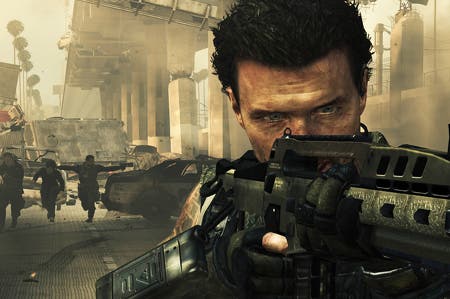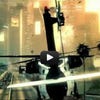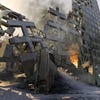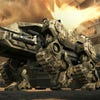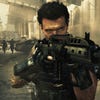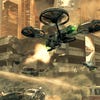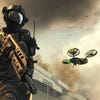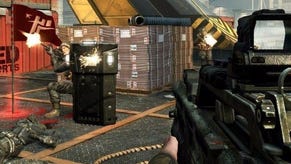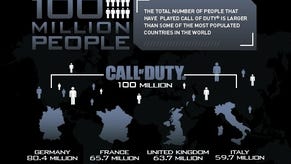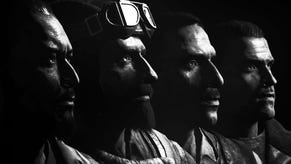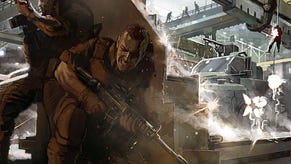Call Of Duty: Black Ops 2 Preview: Appetite for Destruction
Treyarch goes big for its blockbuster sequel.
It may be a sad indication of how the proverbial blockbuster has evolved over the years, but recently I've started to judge popcorn movies and triple-A shooters based on how entertainingly they destroy cities. Over the last half decade I've seen so many famous cities wiped off the map for my amusement, I now expect games developers and film directors to exhibit both originality and creativity in how they orchestrate violent urban renewal.
Whether you're a fan of their work or not, one can't deny that Infinity Ward is a past master when it comes to this sort of thing. It's also to the developer's credit that reducing urban conurbations to piles of rubble isn't entirely about upping the shock and awe ante; there's something genuinely disturbing on an emotional level about seeing landmarks such as the New York Stock Exchange, the London Underground and the Washington Memorial with chunks blown out of them.
If all of that sounds disturbing, then consider this: it also constitutes part of what gamers expect from the 'authentic Call Of Duty experience', which Treyarch's Community Manager John Rafazz says lies at the heart of what the Santa Monica developer is trying to deliver with the single-player campaign for Call Of Duty: Black Ops 2.
Up until recently, Treyarch has never really had this dramatic foil available to them. COD: World At War was set in WWII, so the environment of a world gone to pot was both expected and documented. In Black Ops, wanton destruction had to dovetail with the history of the Cold War and so the player was, once again, either dumped into established theatres of war (like Cuba or Vietnam) or clandestine installations - and blowing up a secret Russian space installation doesn't carry the same dramatic heft as storming the White House.
This is all about to change with Black Ops 2, which updates the Cold War setting to the not-too-distant future. It may sound unfair to posit the idea this has been done solely to use the destruction of the modern world as grist for the game's dramatic mill, but the first-look of the game lends some small measure of credence to this theory.
The action starts in a Hummer on the freeway into Los Angeles, where, from a first-person perspective, we all watch as a be-suited government type chokes to death on his own blood. The game's protagonist, David Mason (yes, he's related to the protagonist in the first game) is screaming at a comrade in arms called Harper (not really sure who he's related to) about how the pair of them are going to save the life of the President Of The United States - who just happens to be sat right beside them in the Hummer.
Outside, all hell is breaking loose. UAV's and robot tanks are dismantling the City Of Angels. Apparently a central AI command program for these machines of death has been hacked by… well, we don't know, but the name Hernandez is being bandied about by the game's protagonists.
"When we were researching the future of warfare for this game," says Rafazz, "we uncovered a future that is incredibly networked - one that relies heavily on drone warfare and advanced robotics. So in a future where there's an electronic pulse running through everything on the battlefield, we asked ourselves, 'what would happen if someone hacked into its infrastructure and turned everything that was supposed to protect us against us?'"
This cyber attack Rafazz is talking about in the game has resulted in unmanned military drones blasting seven shades of excrement out of their human counterparts in a spectacle as disturbing as it is eardrum-splitting. The game's soundtrack thunders as jets roar overhead, missiles throw chunks of highway into the air and tires scream as the protagonists' Hummer veers left and right. Suddenly, the entire screen's POV shudders and the vehicle bounces end over end as a stray rocket blasts out its front axle.
Remember when I said that I rate a blockbuster's success on its ability to smash up a city? Well, Treyarch earn top marks in the demo they serve up. It's not just the gargantuan amount of chaos they splash across the screen; it's also the mind-blowing way in which they present it. As I watch Mason and co. exit their vehicle, and duck down, cars and trucks bounce towards them and then spin overhead in slow-motion, scattering parts of themselves everywhere while the sound bleeds out into muffled thuds and cries, ensuring my attention is utterly arrested. A jaw falling open is almost an involuntary reaction.
That's just the opening ten seconds or so, by the way. As the demo continues, Mason uses a rocket launcher mounted on the back of a Hummer to fend off some attacking drones as the vehicle is falling through a hole in the freeway. As the last UAV is dispatched, he frantically clambers up the vehicle, just before it scrapes through the crevice and pancakes on the street below.
The action moves swiftly, to Mason sniping enemies from a freeway, to a frantic shootout in a shopping mall, to a pitched battle on the streets of LA. During this segment, we see Mason take out a series of high-tech opponents including remote quad-copter drones and four-legged tanks. It all seems to err on the side of science fiction, but no, Rafazz assures us everything's above board.
"When it came to defining the not-too-distant future and making sure that we were remaining true to the COD authentic experience, we took all our research on weaponry to [senior fellow at the Brookings Institute] Peter Singer," he says. "And where we thought we were going too far, he told us we weren't going far enough.
If Rafazz is to be believed, the future of modern warfare looks like a terrifying place to be. This is a world where soldiers can unleash hellish carnage by tapping a touchscreen pad on their arm, sending swarm of drones to pepper opponents with machinegun fire. It's a place where UAVs have the destructive power of a squadron of fighters, and where gun clips carry rounds powerful enough to shoot through the support column of a freeway.
"All the equipment you saw in the game," intones Rafazz, "is stuff that is in use, in advanced prototyping stages or in prototype stages. If you look at what processing power in technology can do over time, there's nothing in our game that's implausible or in the realm of science fiction."
As we take in this fantastic damage, the shuddering screen and head-banging soundtrack reinforces the fact that a dogfight is in progress overhead. If any further reminder were needed, the end section of the demo sees Mason leap into a jump jet and take to the air to do battle with unmanned bombers (in a fight which, we are told, is not on rails), but not before a catastrophic explosion drops a skyscraper into the middle of downtown LA.
"The COD single player experience is pretty well documented," says Rafazz. "It has epic cinematic moments and huge set-pieces but it retains an element of authenticity and plausibility."
That's the main challenge for Treyarch really, to marry blockbuster shooter action in their game with the player's expectation that when they crank a round into the breach of a Franchi SPAS-12, it sounds like the real thing. The other challenge is to pack enough innovation into their game to surprise consumers, who right now expect a bombastic single-player, an addictive multiplayer and, of course, zombies. Rafazz says all of those aspects will feature in Black Ops 2, but Treyarch 9s adding something new to the single-player campaign in the form of Strike Force missions.
Described by Rafazz as proxy wars, Strike Force missions are essentially side quests to the single-player campaign. At various stages in the main narrative, players are dumped into a scenario in which they have certain objectives to complete. From the demo I was shown, in which a squad of soldiers and their robot helpers had to secure points on a map before launching a missile at a tanker, the structure of the missions looks to be fairly open-ended.
Players switch between avatars in the team, taking control of soldiers, air-drones, walking tanks and they can even zoom back to an Overwatch position and direct the battle from afar. If the robot or human they're controlling gets killed, they simply transfer to the closest nearby ally. In a rare occurrence for a single-player shooter mode, there are no do-overs. Once all the player's crew are dead, they fail the mission.
Rafazz also says the Strike Force missions have an impact on the main single-player campaign, although his explanation is a little hazy.
"At the conclusion of the single-player campaign, if you succeeded at all of your Strike Force levels, it'll wrap your ending for your campaign in a different geo-political fiction than mine, if I say, fail all my Strike Force missions," he says. "This isn't about disparate endings. This is about you and I playing for the same present with different colour wrapping paper - although that's a gross oversimplification. I wish I could be a bit more specific but then I risk giving plot points away."
It's Rafazz's and Treyarch's hope that, like the unlockable zombie mode in World At War, Strike Force will take on a life of its own with players, and if it does, it's likely to give the studio another slab of creative space to play in. This would clearly help, especially if they expect to stand a chance of competing with the last game they released.
In the days before the first Black Ops, Treyarch was looked at as the second tier COD developer, holding the fort for Activision between Modern Warfare releases. That all changed when Black Ops became the best selling COD game to date, and Treyarch know they're expected to improve on this. While it's obviously too early to predict if this will be the case, I can report Black Ops 2 showcases some of the most eye-watering and entertaining destruction I've seen in a video game all year. It's not subtle by any means, but it's what the COD faithful expect, and it certainly looks more explosive than anything Treyarch has done before.
